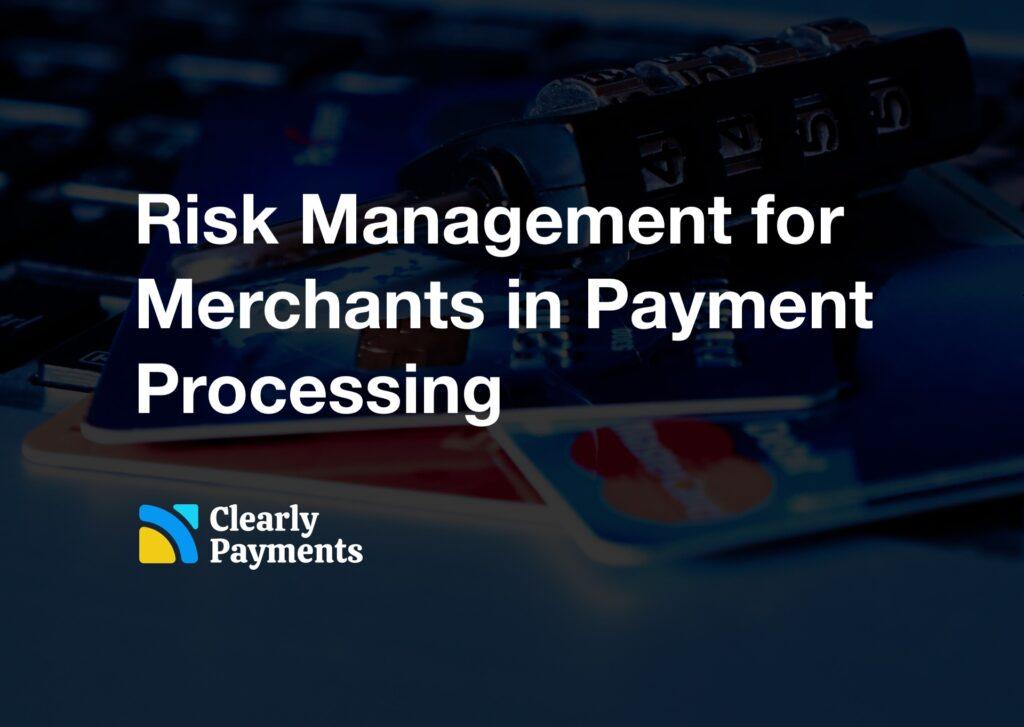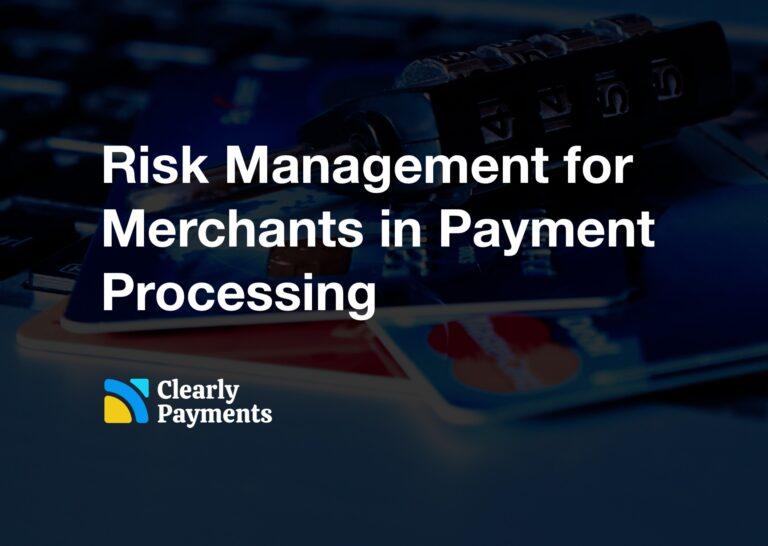In the rapidly advancing world of payments and eCommerce, merchants find themselves navigating a landscape of risk in payment processing. While these technologies bring unparalleled convenience and global reach, they also introduce a plethora of risks that can impact the financial stability and reputation of businesses. In this guide, we go into the topics of risk management in payment processing, equipping merchants with the knowledge and strategies needed to secure their transactions.
Identifying and Assessing Risks
Understanding the lay of the land is the first step in effective risk management. Merchants must familiarize themselves with the diverse risks associated with payment processing, encompassing fraud, chargebacks, and cybersecurity threats. Conducting a thorough risk assessment tailored to the specific nature of the business is essential. By identifying potential vulnerabilities, merchants can take targeted actions to mitigate risks before they escalate.
Types of Risk that Merchants Should Manage
Merchants engaged in payment processing face various types of risks that can impact their financial stability, reputation, and overall business operations. Understanding and effectively managing these risks is crucial for maintaining a secure and trustworthy payment environment. Here are some key types of risks that merchants should be mindful of in payment processing:
Fraud Risk: Fraud risk involves unauthorized or deceptive activities aimed at exploiting the payment system for financial gain. This can include stolen credit card information, identity theft, or fraudulent transactions.
Chargeback Risk: Chargebacks occur when customers dispute a transaction and request a refund directly from their bank. Excessive chargebacks can lead to financial losses and damage a merchant’s reputation.
Security, Compliance, and Regulatory Risk: Cybersecurity risk involves the threat of data breaches and unauthorized access to sensitive payment information. Hackers may exploit vulnerabilities in the merchant’s system to gain access to customer data.
Currency and Exchange Rate Risk: For merchants involved in international transactions, currency fluctuations can impact the value of transactions. Exchange rate risk can lead to unexpected gains or losses.
Market and Reputational Risk: Market and reputational risk involves the potential damage to a merchant’s brand and customer trust. Negative publicity, customer dissatisfaction, or association with controversial practices can impact a merchant’s reputation.
Effectively managing these types of risks requires a proactive approach, combining technological solutions, compliance measures, and operational strategies to create a secure payment processing environment for both merchants and customers.
Fraud Risk and Prevention Techniques
Managing fraud risk in payment processing requires a strategic and adaptable approach from merchants. The first step is implementing robust authentication processes, including multi-factor authentication, biometric verification, and tokenization, to enhance user access security. Additionally, leveraging advanced fraud detection tools and machine learning algorithms in real-time helps analyze transaction patterns and differentiate between legitimate and potentially fraudulent activities.
Regularly monitoring transaction patterns is crucial, allowing merchants to swiftly respond to anomalies and deviations from established baselines. Staying informed about emerging fraud trends is equally important, as fraudsters continually refine their tactics. To fortify customer verification processes, especially for high-risk transactions, merchants can conduct manual reviews, verification calls, and additional documentation checks.
Empowering customers to be vigilant about their own security is another key aspect. Providing educational materials, including fraud prevention tips, and encouraging the reporting of suspicious activities establishes a collaborative defense against fraud.
Chargeback Management Best Practices
Chargebacks pose a significant challenge for merchants, impacting both financial stability and reputation. Chargebacks are generally the biggest concern that most merchants have. Implementing effective chargeback management practices is essential to minimize their occurrence and address disputes promptly. Read this article on what is a good chargeback rate. Here are some best practices for merchants to navigate chargeback management successfully:
Transparent Communication and Clear Policies
Merchants should establish transparent communication channels with customers, providing clear and detailed information about products, services, and terms of purchase. Clearly communicated policies on refunds, cancellations, and returns can reduce the likelihood of misunderstandings and subsequent chargebacks.
Prompt Customer Service Response
Timely and responsive customer service is crucial. Addressing customer queries and concerns promptly can prevent frustration and dissatisfaction, reducing the likelihood of customers resorting to chargebacks to resolve issues.
Detailed Transaction Descriptors
Ensure that transaction descriptors on customers’ statements clearly identify the business, making it easier for customers to recognize the charge. Ambiguous or unfamiliar descriptors can lead to confusion and unintentional chargebacks.
Secure and Well-Documented Transactions
Merchants should maintain comprehensive transaction records, including order confirmations, shipping details, and customer communication. This documentation can serve as evidence in case of disputes, providing a basis for effectively challenging unwarranted chargebacks.
Employee Training on Chargeback Procedures
Train employees involved in customer service and order fulfillment on chargeback procedures. Ensuring that staff understands the process, documentation requirements, and the importance of clear communication can contribute to effective chargeback management.
Managing Security, Compliance, and Regulatory Risk
In the realm of payment processing, safeguarding sensitive data is paramount for both the merchant and the customer. A crucial aspect of risk management involves adhering to the Payment Card Industry Data Security Standard (PCI DSS), which sets stringent guidelines for securing payment transactions and protecting cardholder information. Here are key practices for merchants to effectively manage data security and achieve PCI DSS compliance:
Implement Robust Encryption Protocols
To protect sensitive data during transmission, merchants should implement robust encryption protocols. This ensures that any information exchanged between the customer and the merchant’s systems remains secure and confidential.
Tokenization for Additional Layer of Security
Tokenization adds an extra layer of security by substituting sensitive data with a unique token. This means that even if unauthorized access occurs, the actual payment card information remains inaccessible, mitigating the risk of data breaches.
Secure Network Configurations
Configuring secure networks is fundamental to PCI DSS compliance. Merchants must establish and maintain secure network configurations to prevent unauthorized access to payment card data, minimizing the risk of data compromise.
Regular Security Audits and Vulnerability Assessments
Conducting regular security audits and vulnerability assessments is essential to identify and address potential weaknesses in the system. This proactive approach allows merchants to fortify their defenses and stay ahead of evolving security threats.
Access Control Measures
Implementing strict access control measures ensures that only authorized personnel have access to sensitive data. This includes limiting access based on job responsibilities, employing unique login credentials, and promptly revoking access for terminated employees.
Maintain Comprehensive Data Protection Policies
Develop and maintain comprehensive data protection policies within the organization. Clearly outline how sensitive customer information is handled, stored, and transmitted, ensuring alignment with PCI DSS requirements.
Engage Third-Party Security Experts
Consider engaging third-party security experts, such as TRC-Parus, to conduct independent assessments and provide insights into potential vulnerabilities. External expertise can offer a fresh perspective and ensure a thorough evaluation of the security measures in place.
By diligently following these practices, merchants can not only achieve PCI DSS compliance but also establish a robust foundation for data security. This proactive approach to risk management ensures the protection of sensitive information, instills customer confidence, and fortifies the merchant’s reputation in the competitive landscape of payment processing.
Currency and Cross Border Payments Risk
Currency and exchange rate risk present significant challenges for merchants engaged in international transactions, potentially impacting the financial outcomes of their endeavors. To effectively manage these risks, merchants can adopt various mitigation strategies. One approach is to utilize currency hedging instruments such as forward contracts, options, and futures to safeguard against adverse exchange rate movements. Collaborating with financial institutions to implement tailored hedging strategies can provide a level of certainty for future transactions. Additionally, implementing dynamic pricing strategies allows merchants to adjust prices in real-time based on currency fluctuations, helping maintain profit margins amidst changing exchange rates. Diversifying currency holdings is another prudent strategy, spreading risk across multiple currencies and reducing exposure to adverse movements in any single currency.
Negotiating favorable terms with suppliers and partners is essential; agreements that include stable currency pricing or mechanisms to share the impact of exchange rate fluctuations can provide mutual benefits. Continuous monitoring and analysis of currency markets, economic indicators, and geopolitical events are crucial for staying informed about potential risks. To enhance risk awareness and decision-making, educating relevant teams within the organization on currency risk management is essential. By incorporating a combination of these strategies, merchants can proactively navigate and minimize the impact of currency and exchange rate risks on their international transactions, ensuring a more stable and profitable financial outcome.
Managing Reputational Risk
Effectively managing market and reputational risk is paramount for merchants seeking to establish and sustain a positive brand image while fostering trust among customers. The potential impact of negative publicity, customer dissatisfaction, or association with controversial practices underscores the need for a proactive approach to risk management. In navigating and mitigating these risks, merchants can adopt a set of best practices tailored to safeguarding their reputation and ensuring customer confidence.
One key practice involves prioritizing customer satisfaction through the delivery of exceptional customer service. Timely responses to inquiries, efficient resolution of issues, and an overall positive customer experience contribute significantly to mitigating reputational risk. Transparent communication is another crucial aspect, where merchants should clearly articulate policies, practices, and any changes to prevent misunderstandings that might lead to negative perceptions among customers.
Real-Life Reputational Risk Example with Equifax
One real-life example of a big merchant that had to manage reputational risk is the case of Equifax, a major credit reporting company. In 2017, Equifax experienced a massive data breach that exposed the personal information of approximately 147 million people. The breach included sensitive data such as names, Social Security numbers, birth dates, addresses, and, in some cases, driver’s license numbers.
The revelation of the breach not only posed significant financial and legal risks for Equifax but also triggered a severe reputational crisis. The company faced widespread public criticism and backlash for its perceived failure to adequately protect the personal information of millions of consumers. The incident highlighted concerns about the security practices of credit reporting agencies and the potential consequences of a large-scale data breach.
In response to the reputational risk, Equifax took various steps to manage the fallout. The company engaged in extensive communication efforts to address the concerns of affected individuals, offering free credit monitoring services and implementing measures to enhance cybersecurity. Equifax also faced regulatory scrutiny and legal consequences, further emphasizing the need for a comprehensive and strategic approach to reputational risk management.
Creating a Risk Management Plan
Creating a comprehensive risk management plan is a foundational step for merchants seeking to navigate the complex landscape of payment processing with confidence. The process begins with a thorough risk assessment, during which merchants analyze potential vulnerabilities and evaluate the impact and likelihood of various risks specific to their operations. This assessment serves as the groundwork for developing strategies to mitigate these identified risks.
Building on the insights gained from the risk assessment, merchants can tailor their risk management strategies to align with the unique needs of their business. This may involve implementing robust authentication processes to secure user access, adopting advanced fraud detection tools to identify and prevent unauthorized activities, and establishing secure data protection measures in accordance with industry standards, such as the Payment Card Industry Data Security Standard (PCI DSS).
A well-crafted risk management plan is not static; it evolves with the ever-changing landscape of payment processing. It incorporates contingency measures and response protocols to address unforeseen challenges or security incidents swiftly and effectively. Regular monitoring of the implemented strategies ensures ongoing effectiveness and allows merchants to adapt their risk management plan in response to emerging threats or shifts in industry regulations.




